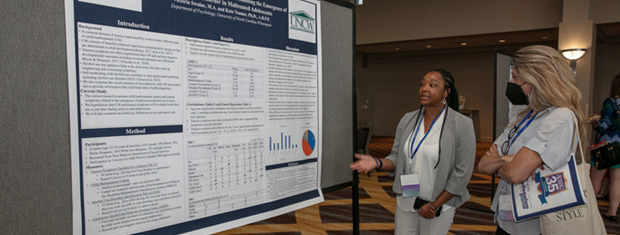




The APSAC Advisor is a peer reviewed quarterly news journal for professionals in the field of child abuse and neglect.
The APSAC Advisor provides succinct, data-based, practice-oriented articles that keep interdisciplinary professionals
informed of the latest developments in policy and practice the field of child maltreatment. It is designed to highlight
best practices in the field and publish original articles and current information about child maltreatment for professionals
from a variety of backgrounds including medicine, law, law enforcement, social work, child protective services, psychology,
public health and prevention in the U.S.
 If you wish to learn more about submitting an article to the Advisor, please click here.
If you wish to learn more about submitting an article to the Advisor, please click here.
This library contains Advisor issues dating back to the first issue in 1988. The most recent issue appears at the top.
Scroll down to select past issues by year and issue number. Once a publication appears in the box, you
can use the Enlarge button to open the document in a new window or tab (depending on how your browser is set up).
This will allow you to view the document with larger print.
To print a document, first use the Enlarge button to open the document in a new window or tab. Then use your browser's Print command.
To return here from a new tab, close the tab. To return from a new window, click your browser's Back button.
In the listing below, click on a year and issue number to see the articles in that publication.
2024 Number 2
How Is Positive Parenting Defined and Measured? A Review of Literature
More than 500 peer-reviewed studies that used the term “positive parenting” in the title or abstract, or both, were identified from a computer search. They were then coded to address three questions: (1) Were the three founders of the parenting approach referenced? (2) How was the term conceptually defined? and (3) How was the construct measured? Findings revealed that with only a few exceptions, the founders are not recognized or referenced in the academic parenting literature. Two-thirds of the studies did not offer a conceptual definition of the term, and measurement of the construct was inconsistent and frequently haphazard. Although positive parenting is a widely used term and has a strong theoretical basis, the empirical literature is not coherent in either its conceptualization or measurement of it.
The current paper is based on an interview with Sharon Doty, MHR, JD, an expert in childhood sexual abuse prevention. Sharon and her team developed a unique approach to the prevention of childhood sexual abuse that involves educating adults about eight common behaviors that sex offenders use to groom children. Sharon’s approach is designed to take the onus off children for protecting themselves by teaching adults how to intervene in potential instances of grooming and how to reduce the potential for grooming by not normalizing eight risky behaviors commonly used by sex offenders. Widespread adoption of interventions such as her Keeping Them Safe program hold promise for preventing child sexual abuse.
Addressing the Outliers: Urging Consensus in Child Sexual Abuse Evaluations
Attached is a commentary written by the four nurse practitioners at Our Kids Center in Nashville, Tennessee. It was written as a response to and in support of “Interpretation of Medical Findings in Suspected Child Sexual Abuse: An Update for 2023” authored by Kellogg, Farst, and Adams and published in September 2023. It further highlights the need for consistency in practice and evidence-based interpretation of findings in child sexual abuse forensic medical exams. Our Kids Center is an outpatient clinic of Nashville General Hospital and affiliated with Monroe Carell Jr. Children’s Hospital at Vanderbilt. The nurse practitioners are adjunct faculty at the Vanderbilt University School of Nursing. In the 37+ years of providing care to children with concerns of sexual abuse, Our Kids Center has evaluated over 31,000 children and serves approximately 47 counties across middle Tennessee.
The StepWise approach to interviewing is an evidence-based, memory-informed, semi-structured model for conducting investigative interviews that has been in use since the 1990s. In Canada, the StepWise approach to interviewing is widely recognized as a leading model for interviewing children and youth in the criminal and child protection context. The StepWise 360, the latest iteration, incorporates new theoretical, empirical, and practical developments in the field. A key feature of the StepWise 360 is that it is adaptable to various types of investigators, such as police, child protection workers, or mental health specialists, to gather reliable information from victims, witnesses, suspects, and clients of all ages. Each step of the StepWise model is discussed within the context of relevant empirical literature. Methods to tailor the interview to each interviewee in a client centered, trauma-informed manner, and deal with present real-world limitations are discussed.
Improving Advocacy for Children Placed in Congregate Care Facilities
This commentary argues for a shift in how child welfare advocates and lawyers represent youth placed in congregate care facilities and for ending the practice of placing youth in out-of-state congregate care facilities. Congregate care facilities, and especially for-profit facilities, have recently come under intense scrutiny for abuses occurring within their walls. Advocates working directly with youth need to better understand their clients’ congregate care experiences as well as the remedies that are available for these young people when they have experienced harm. These remedies include reporting abuses to the proper authorities and watchdog agencies, initiating civil actions, participating in systemic reform efforts, and engaging in legislative advocacy. Further, no child should be placed in out-of-state congregate care facilities, which are costly, subject to less oversight, and far from youths’ advocates, communities, and support networks.
APSAC Advisor 37(2) - Full Issue